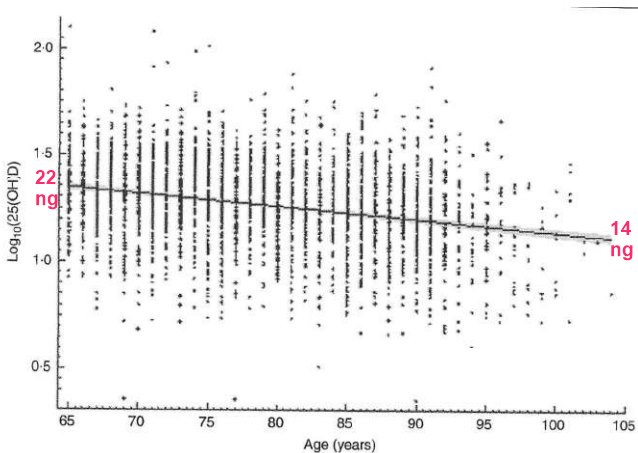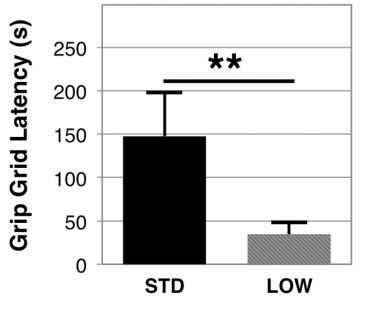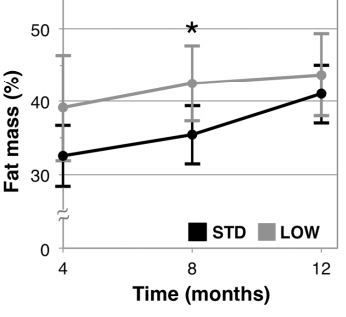Muscle, etc. problems if consume little vitamin D (mice)
Chronic vitamin D insufficiency impairs physical performance in C57BL/6J mice.
Aging (Albany NY). 2018 Jun 14. doi: 10.18632/aging.101471. [Epub ahead of print]
Seldeen KL1, Pang M1, Leiker MM1, Bard JE2, Rodríguez-Gonzalez M1, Hernandez M1, Sheridan Z1, Nowak N2, Troen BR1.
📄 Download the PDF from VitaminDWiki
Vitamin D levels vs month

How long grip remains strong

% of fat mass

Vitamin D insufficiency (serum 25-OH vitamin D < 30 ng/ml) affects 70-80% of the general population, yet the long-term impacts on physical performance and the progression of sarcopenia are poorly understood. We therefore followed 6-month-old male C57BL/6J mice (n=6) consuming either sufficient ( STD, 1000 IU) or insufficient (LOW, 125 IU ) vitamin D3/kg chow for 12 months (equivalent to 20-30 human years). LOW supplemented mice exhibited a rapid decline of serum 25-OH vitamin D levels by two weeks that remained between 11-15 ng/mL for all time points thereafter.
After 12 months LOW mice displayed worse
grip endurance (34.6 ± 14.1 versus 147.5 ± 50.6 seconds, p=0.001),
uphill sprint speed (16.0 ± 1.0 versus 21.8 ± 2.4 meters/min, p=0.0007), and
stride length (4.4 ± 0.3 versus 5.1 ± 0.3, p=0.002).
LOW mice also showed
less lean body mass after 8 months (57.5% ± 5.1% versus 64.5% ± 4.0%, p=0.023),
but not after 12 months of supplementation,
as well as greater protein expression of atrophy pathway gene atrogin-1.
Additionally, microRNA sequencing revealed differential expression of mIR-26a in muscle tissue of LOW mice.
These data suggest chronic vitamin D insufficiency may be an important factor contributing to functional decline and sarcopenia.
PMID: 29905532 DOI: 10.18632/aging.101471
CONCLUSION
Serum 25-OH vitamin D declines rapidly and remains consistently depressed in response to low supplementation. Prolonged vitamin D insufficiency induces characteristics of sarcopenia that include poor anaerobic capacity, lower lean mass, and a trend towards smaller fast twitch fiber CSA, as well as gait disturbance. Vitamin D insufficient mice also exhibited increased expression of atrophy-associated Atrogin-1 and differential expression of muscle regulation associated miR-26a. These data suggest a role for chronic vitamin D insufficiency in the development of sarcopenia, highlighting the need for further animal and human studies to investigate the impacts of vitamin D during aging.
